This folksinger’s only LP, produced by Paul Simon in 1965:
July 2016
Fri 22 Jul 2016
Music I’m Listening To: JACKSON C. FRANK – His Only LP.
Posted by Steve under Music I'm Listening ToNo Comments
Thu 21 Jul 2016
Reviewed by William F. Deeck: EDWIN LANHAM – Politics Is Murder.
Posted by Steve under Authors , Reviews[3] Comments
William F. Deeck
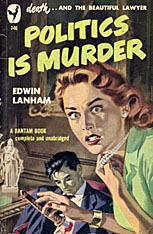
EDWIN LANHAM – Politics Is Murder. Harcourt Brace & Co., hardcover, 1947. Bantam #746, paperback, 1950.
Since he would rather be playing chess, Jeff Stover is unhappy with his unsought appointment to the New York City Council. Still, it does give him a chance to set the cat — one Sachem McKeever. presently stuffed — among the pigeons by proposing a law to change the name of McKeever Place to Niebach Square, Niebach being his deceased predecessor.
A mild new law, one would think. but it makes some people unhappy. so unhappy, in fact, that someone inserts a samurai sword into Stover while he is sitting at his desk in City Hall.
George Wright, City Hall reporter, catches Stover’s former fiancee at the scene with blood on her hands. Since he is smitten with her, she must be not guilty. She also isn’t innocent, for while he lies for her, she tells untruths about him.
A good reporter but a dimbulb is Wright. Luckily there’s an intelligent and incorruptible cop with a long memory to do the real investigating in a good fair-play novel.
Bibliographic Notes: The cop that Bill referred to in his last paragraph must be Lt. Madigan, who first appeared in print in Slug it Slay (1946), and whose third recorded case was One Murder Too Many (1952). Between 1946 and 1963 Lanham was the author of a total of 12 crime novels listed in Hubin. Throughout his career, he was also a prolific author of serials and short fiction for the slick magazines such as Collier’s and The Saturday Evening Post. Lanham was also well enough known as a writer of literary fiction to have a page on Wikipedia.
Thu 21 Jul 2016
Mystery Review: ANTHONY BOUCHER – The Case of the Baker Street Irregulars.
Posted by Steve under Reviews[10] Comments

ANTHONY BOUCHER – The Case of the Baker Street Irregulars. Simon & Schuster, hardcover, 1940. Reprinted as Blood on Baker Street. Mercury #179, digest-sized paperback, abridged, 1953. Also published by Collier AS147, paperback, 1962; Gregg Press, hardcover, 1980; Carroll & Graf, paperback, 1986 & 1995.
In his early days as a mystery writer, renowned mystery critic Anthony Boucher was apparently much taken by the Ellery Queen school of detective puzzle writing, the more complicated the plot, the better. And as the title indicates, TCOT Baker Street Irregulars mixes in a quintuple dose of Sherlock Holmes as well.
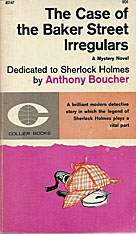
There is a locked room mystery, codes to be deciphered — or should that be ciphers to be uncoded? — a large cast of characters, all trying to solve the mystery and all with (at the same time) alibis to be tested and broken, with ingenious solutions proposed by all and sundry, none of which hold up to the light of day — all with the zest and wit of an author who in his own way was a genius of the first rank indeed.
Dead is Stephen Worth, a hardboiled writer who hates Holmesian puzzles, but who has unaccountably been hired to write the screenplay for Metropolis Pictures’ latest project, that of filming their version of “The Adventure of the Speckled Band.” Protesting are all of the members of the Baker Street Irregulars around the country, five of whom are invited to come to Hollywood and be creative consultants on the project, mostly to keep them mollified and quiet.
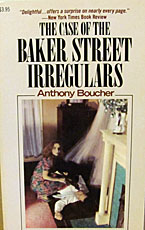
Boucher’s most frequently used series character, Hollywood PI Fergus O’Breen is not on hand, but his sister Maureen is. She’s the trusted assistant to the head of Metropolis Pictures, and it becomes her job to keep an eye on the Irregulars (it was her idea, after all), all housed in one building. Who’s the housekeeper? None other than a young lady named Mrs. Hudson. Who’s the policeman who given the task of watching over the house after the murder occurs? None other than Sergeant Watson.
It is hard to keep the level of wackiness exhibited by the first third of the book going indefinitely, and the middle third sags noticeably, while the ending seems entirely too jerry-rigged to hold up against a bout of serious questioning. So I didn’t and I won’t. I just sat back and enjoyed it immensely. Not a book for modern readers, to be sure, but if your tastes are anything like mine, you’ll have a good time with this one too.
Wed 20 Jul 2016
A TV Series Review by Michael Shonk: COURT MARTIAL (1966).
Posted by Steve under Reviews , TV Drama[13] Comments
by Michael Shonk
COURT MARTIAL. ABC; April 8 – September 2, 1966. Roncom Films,inc / ITC Presentation / MCA TV / Universal TV. Cast: Bradford Dillman as Captain David Young, Peter Graves as Major Frank Whittaker, Kenneth J. Warren as Sgt. John MacCaskey, and Angela Brown as Sgt. Yolanda Perkins or Diane Clare as Sgt. Wendy. Produced by Bill Hill or Robert Douglas.
By the sixties. television drama was developing a social conscience. Lawyers were among the leaders of this type of drama with series such as THE DEFENDERS, BOLD ONES, and JUDD FOR THE DEFENSE often featuring cases that focused on the issues of the day.
COURT MARTIAL followed that path and occasionally found great dramatic success. The series featured the activity of a small unit of the US Army’s Judge Advocate General’s Office (JAG).
The star was Bradford Dillman as Captain David Young, a dedicated lawyer whose emotions and desire to find the truth often drove him beyond the call of duty. He was also a typical philandering bachelor of the era. Dillman at times overplayed the role as a womanizer, where in some serious scenes while he was questioning women Young was more interested in flirting than listening. Yet Captain Young was the conscience of the series.
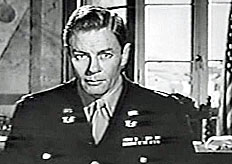
Co-starring was Peter Graves as Major Frank Whittaker, the officer in charge of the unit, and the one who chose the cases Young worked on. Graves was able to make Whittaker likable despite the Major’s loyalty to rules over compassion. He often argued with Young over methods but was flexible enough to let Young follow his passion. Whittaker at times took on a case himself even if it meant he was on the opposite side of Captain Young.
Captain Young described the Major best when commenting, “Isn’t it nice to meet a man who not only has principles but lives by them.â€
The staff consisted of two Sergeants. One was staff aide Sgt John MacCaskey played by Kenneth J. Warren. His basic purpose was to either lighten up the episode or give another character someone to talk to.
Finally there was the staff secretary. The series had two. First was Angela Browne as Sgt Yolanda Perkins. Next was Sgt. Wendy, played by Diane Clare. Both actresses were blonde and nearly interchangeable. Both were successful popular British actors. There was no explanation as to why the character Wendy suddenly replaced Yolanda. From the ten episodes I have seen the only difference between the two was Yolanda was more romantically interested in Captain Young than Wendy was.
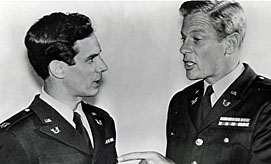
COURT MARTIAL began as a two-part episode on KRAFT SUSPENSE THEATRE. “The Case Against Paul Ryker†(October 10th and 17th, 1963) starred Lee Marvin, Dillman and Graves. The two-part episode would later be re-edited into a movie called SERGEANT RYKER and released to theatres in 1968. The action took place in the Korean War.
In 1966 British TV network/syndicator ITC with Roncom Production decided to do a weekly series based on the episode with both Dillman and Graves returning. Not surprisingly the action shifted to WWII, a war more familiar to the British viewers that watched the series on the ATV network.
COURT MARTIAL became part of the late 60s British invasion to American network TV when ABC added THE AVENGERS and COURT MARTIAL to its line-up. ABC wanted to replace reruns with more original programs. COURT MARTIAL would take over for THE JIMMY DEAN SHOW.
Other British series on American TV at the time were THE BARON on ABC and SECRET AGENT (DANGER MAN) on CBS. THE SAINT was scheduled to follow in the fall on NBC. (“Broadcasting†January 31, 1966).
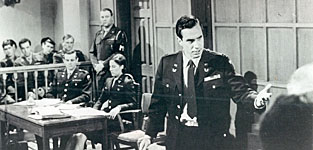
COURT MARTIAL focused on the tragedies of war, avoiding the pat expected happy endings common on much of American TV. Our heroes often lost their cases and the endings could make you wonder if justice had been served. It lasted only one season with 26 episodes filmed of which only 20 were shown in America (ten episodes are currently on YouTube).
The series was more appreciated in England, airing all 26 episodes and winning the British Society of Film and Television (BAFTA) award for Best Dramatic Series.
Production values were cheap. Location shooting was rare with much of the series shot at the Pinewood studio lot. There were too many British actors with bad American accents. Yet the realistic drama and depth of the characters and story more than made up for COURT MARTIAL flaws.
“Judge Him Gently.” June 3, 1966. Written by Gerry Day. Directed by Harvey Hart. Produced by Bill Hill. Supporting Cast: Diane Clare as Sgt. Wendy. Guest Cast: Joan Hackett, Fred Sadoff and Henry Gilbert. *** A badly wounded soldier who faced a life of constant pain and suffering dies after receiving an overdose of morphine. Captain Young is assigned to prosecute a hospital corpsman that had been drunk at the time.
After Young wins his case against the corpsman the Nurse in charge confesses she administered the fatal dose when the patient begged her to end his life. No one but Young wants to defend her and the act of euthanasia.
One of the best episodes of the series. Brilliantly written by Gerry Day, perhaps the best TV script she ever wrote in her successful fifty-year career. She was able to show the effects of war from the perspective of a female nurse. Joan Hackett was outstanding playing the tense emotionally broken nurse, adding an intensity and tragedy to the all ready powerful story.
The episode rejected melodrama for realism. It took on the issue of euthanasia as well as the cruelness of war with sensitivity and compassion. It rejected emotional scenes for scenes that showed the motives of all and the pain each dealt with inside. And most important it rejected judgmental easy answers.
“Taps for the Sergeant.” April 15, 1966. Written by Daniel Mainwaring. Directed by Peter Maxwell. Produced by Bill Hill – Supporting Cast: Diane Clare as Sgt Wendy. Guest Cast: Lee Montague, Moira Redmond, and George Roubicek. *** France, August 1944. Major Whittaker takes on the defense of a Sergeant who had fought with the French Foreign Legion and the French Underground before he joined the American Army. The Sergeant had disobeyed an order, an order that cost 12 men their lives.
https://www.youtube.com/watch?v=MIVHB0M0EGo
The story of the Sergeant was dramatic enough but it also presented an effective look at the depth of Major Frank Whittaker. The ending is a good example of the series attempt at showing the darkness of war and the uncompromising world of the military.
“Without a Spear or Sword.” June 24, 1966. Written by Mark Rogers. Directed by Peter Maxwell. Produced by Bill Hill. Supporting Cast: Angela Brown as Sgt Yolanda Perkins. Guest Cast: Dennis Hopper. Susan Hampshire and Francis De Wolff.*** Hopper plays a lonely loser, Cpl. Winston that gets caught with a stolen art piece. The piece was part of a private collection that was robbed before it scheduled move to a museum.
https://www.youtube.com/watch?v=Y0oeIf3tI0M
The episode explored the emotional side of Young from his seducing the beautiful woman who worked at the museum to his caring concern for the Corporal. Where Major Whittaker was more disciplined, Young found it difficult not to get personally involved.
COURT MARTIAL was a humorless, depressing quality drama that had little chance in its time slot of Friday at 10pm and opposite then hit series NBC’s MAN FROM U.N.C.L.E. This mix of COMBAT! and THE DEFENDERS deserves to be better remembered but instead joins the too many other forgotten attempts at quality dramas of the era such as SLATTERY’S PEOPLE and THE NURSES.
Wed 20 Jul 2016
JONATHAN LEWIS: Stories I’m Reading — JACK LONDON “The Enemy of All the World.”
Posted by Steve under Science Fiction & Fantasy , Stories I'm Reading1 Comment
JACK LONDON “The Enemy of All the World.” First published in Red Book, October 1908. First collected in The Strength of the Strong (Macmillan, 1914). Anthologized several times, including The Science Fiction Stories of Jack London (Citadel Press, hardcover, 1993). Available online by following the link above.
Jack London’s “The Enemy of all the World†reads more like a work of journalism than a work of fiction. That itself shouldn’t be surprising, given London’s journalism background and extensive corpus of non-fiction writings. What makes this particular short story worth reading, however, is that it’s a work of “journalistic science fiction,†an imaginative recounting of future events from the perspective of the then present.
Published in the October 1908 issue of Red Book, “The Enemy of All the World†unfolds in purely narrative form. Absent is any dialogue or a writing style that would automatically give it away as a work of fiction. The anonymous, distant narrator recalls the life and times of one Emil Gluck, a neglected child who grew up into a vengeful mad genius and who was executed in 1941. Much like a villain in Jules Verne’s works, Gluck is a scientist socially cut off from a society that scorns him.
Also similar to those madmen depicted in Verne’s fiction, Gluck utilizes technology to wage a one-man war against the world. Emil Gluck, dastardly villain that he is, utilizes electro-plating – his “apparatus†to wreak havoc with modern technology:
In the meanwhile Emil Gluck, the malevolent wizard and arch-hater, left no trace as he traveled his whirlwind path of destruction. Scientifically thorough, he always cleaned up after himself. His method was to rent a room or a house, and to secretly install his apparatus— which apparatus, by the way, he so perfected and simplified that it occupied little space. After he had accomplished his purpose he carefully removed the apparatus. He bade fair to live out a long life of horrible crime.
Fortunately for society, the western powers’ secret services are on Gluck’s trail. It is one intrepid U.S. secret service agent by the name of Silas Bannerman (a perfect name, right?) who finally tracks Gluck down and makes him his prisoner.
A story with more than a hint of political commentary, “The Enemy of all the World†is worth consideration both as a work of early science fiction and as further evidence that London, who was involved in socialist politics in the Bay Area, had political views that weren’t so easily categorized.
Wed 20 Jul 2016
Reviewed by Barry Gardner: BRIAN FREEMANTLE – Comrade Charlie.
Posted by Steve under Reviews[6] Comments
BRIAN FREEMANTLE – Comrade Charlie. Charlie Muffin #9, hardcover, St. Martin’s, US, hardcover, 1992. First appeared in the UK: Century, hardcover, 1989.
I think this is the ninth Muffin book — the idiot US publishers have retitled so many that I can’t be positive I haven’t missed one. Regardless of how many, Freemantle has created one of my favorite espionage characters in the scruffy Muffin.
Charlie is the eternal outsider, the irreverent prole amongst the stuffy aristocrats of England’s secret services. Unfortunately for them, he’s as cunning as a weasel and has a highly developed instinct for self-preservation. He’s already brought down numerous superiors who had thought to rid them-selves of him, and earned several sets of undying enmity in the process. His escapes haven’t been unalloyed with tragedy; his wife was killed in an early book, and he later had to leave a lover behind in Russia.
As usual, Freemantle starts out with several semi-related plot threads, and brings them ever closer as the tale progresses. Charlie’s immediate superior is after him again with dismissal the least of his aims; an old Russian nemesis of Charlie’s is given the job of stealing some Star Wars technology from a plant in England and decides to get even with Charlie in the process; and he enlists Charlie’s old lover, all unwitting as a part of the plan. Will the lovers be reunited, or destroyed? Will Charlie emerge triumphant again, or will this be the time they get him? Well, you’ll just have to read it and see.
And you’l1 enjoy it. Good writing good story, great character. Charlie Muffin is a genuinely engaging maverick, and Freemantle always puts him through some complex, interesting, and readable paces. Great Britain has produced a number of outstanding espionage series, and in my mind Charlie M. ranks with the best. Do it.
Bibliographic Note: Barry’s numerical calculation was quite correct. This was the 9th book in the Charlie Muffin series. Through 2013, there have been 16 in all.
Tue 19 Jul 2016
Music I’m Listening To: STACEY KENT – So Nice.
Posted by Steve under Music I'm Listening ToNo Comments
From this jazz singer’s 2010 CD, A Fine Romance, released jointly with her husband Jim Tomlinson on tenor saxophone.
Tue 19 Jul 2016
A Movie Review by David Vineyard: JIGSAW (1962).
Posted by Steve under Mystery movies , Reviews[3] Comments
JIGSAW. Britannia Films, UK, 1962; Beverly Pictures, US, 1965. Jack Warner, Ronald Lewis, Yolande Donlon, Michael Goodliffe, John LeMesurier, Moira Redmond. Screenplay by Val Guest, based on the novel Sleep Long, My Love by Hillary Waugh. Director: Val Guest.
Hillary Waugh’s first police procedural novel, Sleep Long, My Love, featuring Chief Fred Fellows gets moved to Brighton in England with redoubtable favorite humane British copper Jack Warner (P. C. 49, The Quatermass Experiment, et al) is Chief Inspector Fred Fellows in this excellent procedural noir, that in addition to the Waugh novel, also calls on the actual famous Brighton trunk murders for inspiration.
Detective Sgt. Jim Wilks (Ronald Lewis) gets called out when an estate agents office is broken into over Easter weekend. Nothing is missing save for some papers on a rent house and Wilks raises the ire of the office owner when he is dismissive of the crime, so to calm the waters his uncle and boss, Chief Inspector Fellows, shows up and asks to take a look around the rental property related to the stolen papers.
That’s when he and Wilks find a body, or most of it, in a trunk, a youngish woman with no identity, and no way to tell how she was murdered. The only witnesses are a nosy neighbor, a grocery delivery man, and the estate agent. There are no prints, and the signature on the rental agreement is gone. They know the man they thought to be the woman’s husband is in his thirties, has brown hair, and the kind of common model and color car he drives — nothing more specific.
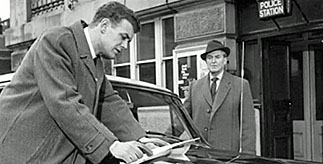
Readers who know Waugh’s books and are long time Fellows fans may be surprised how much transfers across the ocean with few changes. Although some aspects of the book are anglicized, for the most part the plot stays close to its origin as do the characters.
Like most procedural films, the daily routine of police work is emphasized with tired police sacrificing their personal lives to pursue a ruthless killer before he strikes again. Notable moments include a lonely young woman who lives with her father and just misses being the next victim (Yolande Donlan, the American wife of director and writer Guest); the victim’s parents when they finally identify her (John LeMesurier and Moira Redmond both quietly effective); and an ex convict (Michael Goodliffe) with a sex offender charge who fits the profile of the killer perfectly and lied to police, but who Fellows believes is the victim of circumstance.
Low key acting (for the most part, Donlon is a bit over the top), a lucid script that never lets the viewer get lost among the various twists and turns of the investigation, sharp portraits of the people involved, Warner’s very human Fellows, a brilliant bit of work on Fellows part right out of the book, and an nice ironic last moment twist that breaks the killer’s alibi even though it has been mentioned a dozen times in the script — all add up to a superior film set against a background too seldom used.
This one was recently on TCM and is available on YouTube. Go out and find it. It’s a top notch little British procedural noir film with excellent cast and a fine adaptation of the maiden outing in one of the best procedural series ever written. This one is a keeper.
Mon 18 Jul 2016
Movie Review: EMPLOYEES’ ENTRANCE (1933).
Posted by Steve under Films: Drama/Romance , Reviews[2] Comments
EMPLOYEES’ ENTRANCE. First National Pictures/Warner Brothers, 1933. Warren William, Loretta Young, Wallace Ford, Alice White, Hale Hamilton, Albert Gran, Ruth Donnelly. Director: Roy Del Ruth.
While 20 year old Loretta Young is breathtakingly beautiful in this film, star billing rightly goes to Warren William. As Kurt Anderson, the fire-breathing and much hated manager of the Franklin Monroe Department Store, he is the Evil Boss personified, trampling down and firing employees at will who can’t meet his standards, and absolutely cutthroat in his dealings with suppliers who can’t meet their contracted deadlines on time.

He is on the job 24/7, and anyone who can’t keep pace with him is swept aside like yesterday’s dead leaves. Even the board of directors hates him, including the owner of the store himself, but they can’t fire him. Why? Because in the middle of the Depression, the store makes money.
Anderson has one flaw, perhaps. He is not married — he doesn’t have time for a wife, he says — but he does have an eye for the ladies. Which is where the enchanting Madeline comes in (Loretta Young). He seduces her, quite frankly so, even though the scene shifts quickly to the following day. Once on the payroll as a model, though, she catches the eye of Wallace Ford, a miniature Kurt Anderson in the making, but as the latter’s newly appointed assistant — the previous having been summarily dismissed as deadwood with no new ideas in years — he can’t ask her to marry him.
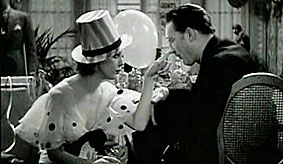
But they do anyway. Get married, that is, and in secret, which means that Madeline must continue to fend off Anderson’s advances, unsuccessfully so, which makes this a somewhat racy comedy as well as a serious romantic drama, one definitely made in the pre-Code era.
But getting back to Warren William, what he does so well is to play an utter cad, but one with good reasons for doing what he does. Deadwood should be replaced. Standing up to the bankers on the board of directors should be done; all they’re interested in the money coming in, with no effort on their part, at the expense of the workers Anderson would have to let go if he were to retrench and cut back as they advise him and as every other business is doing — and failing as a result.
Warren William makes us, the viewer admire, if not quite like him, even as we hate him. That’s a tough job for any actor to pull off, and William makes it look easy.
Mon 18 Jul 2016
Reviewed by William F. Deeck: TIMOTHY KNOX – Death in the State House.
Posted by Steve under Reviews[2] Comments
William F. Deeck
TIMOTHY KNOX – Death in the State House. Houghton Mifflin, hardcover, 1934. Black Cat Detective #24, digest-sized paperback, 1946.
In the Capitol of an unnamed state — internal evidence suggests New Jersey — the Governor is working late. When someone inserts a knife in his neck. he stops working. Since the Governor is a womanizer, a gambler, and an owner of a “speak” and gambling den, he has lots of enemies.i
Called in to investigate is Eli Scott, apple grower and chief of police of a small town. Solving the murder is beyond the dubious talents of the capital city’s police since this is an impossible crime: Those who could have murdered the Governor all clear each other.
An only novel, interesting primarily because it’s a rather good impossible crime for the times.
Bibliographic Notes: Bill was quite correct in saying that this was Timothy Knox’s only novel. What he may not have known is that Knox was the pseudonym of Charles Fisher & Elizabeth K. Read, about either little is known. Fisher, however, was also the author of a short story collection entitled Some Unaccountable Exploits of Sherlock Holmes (1956; perhaps self-published).